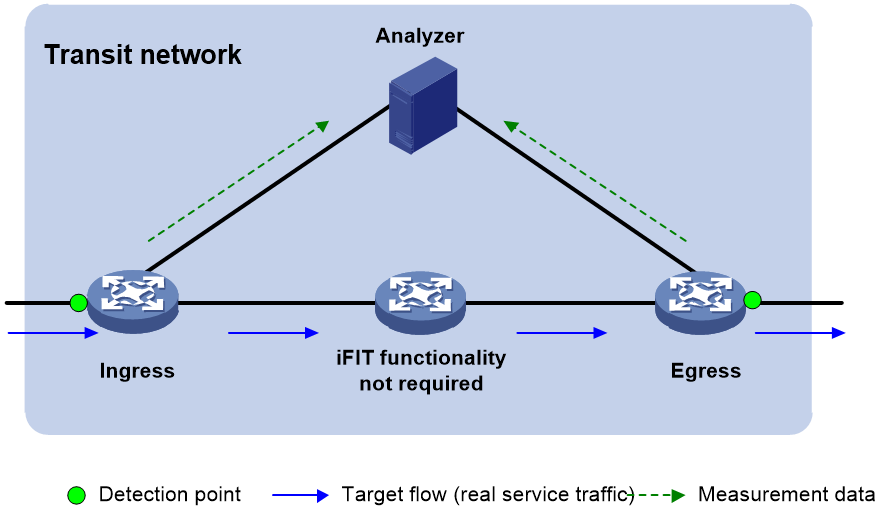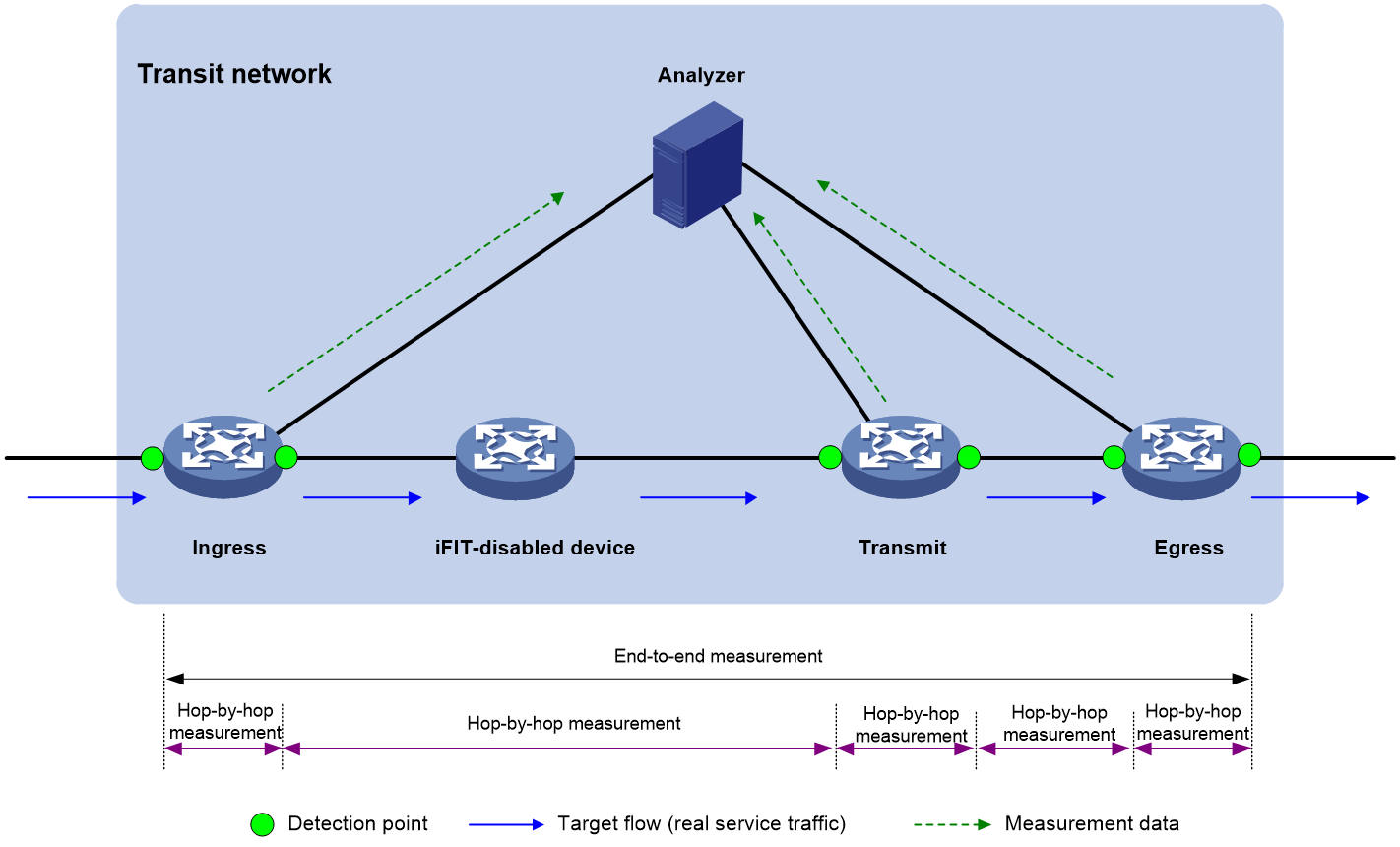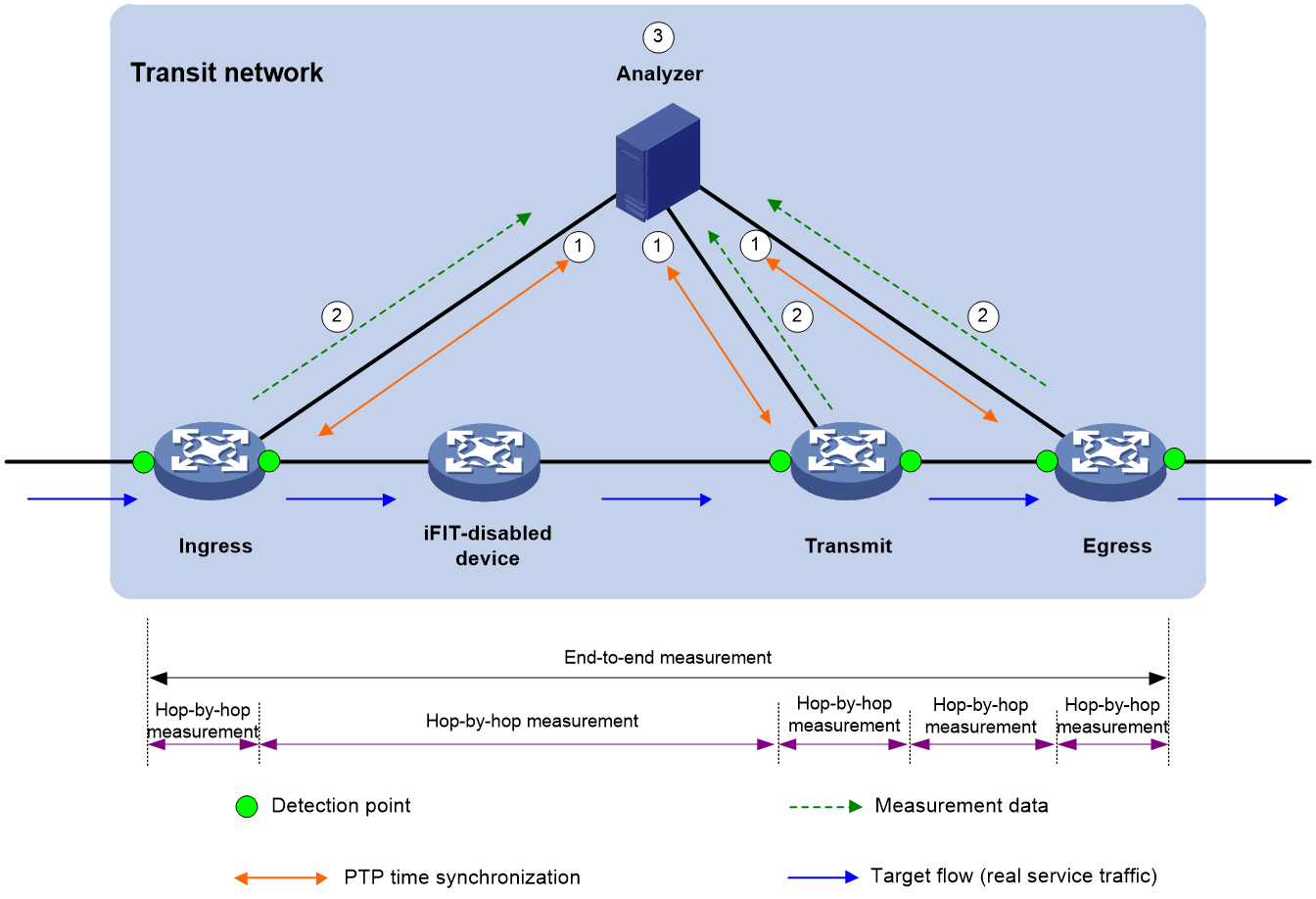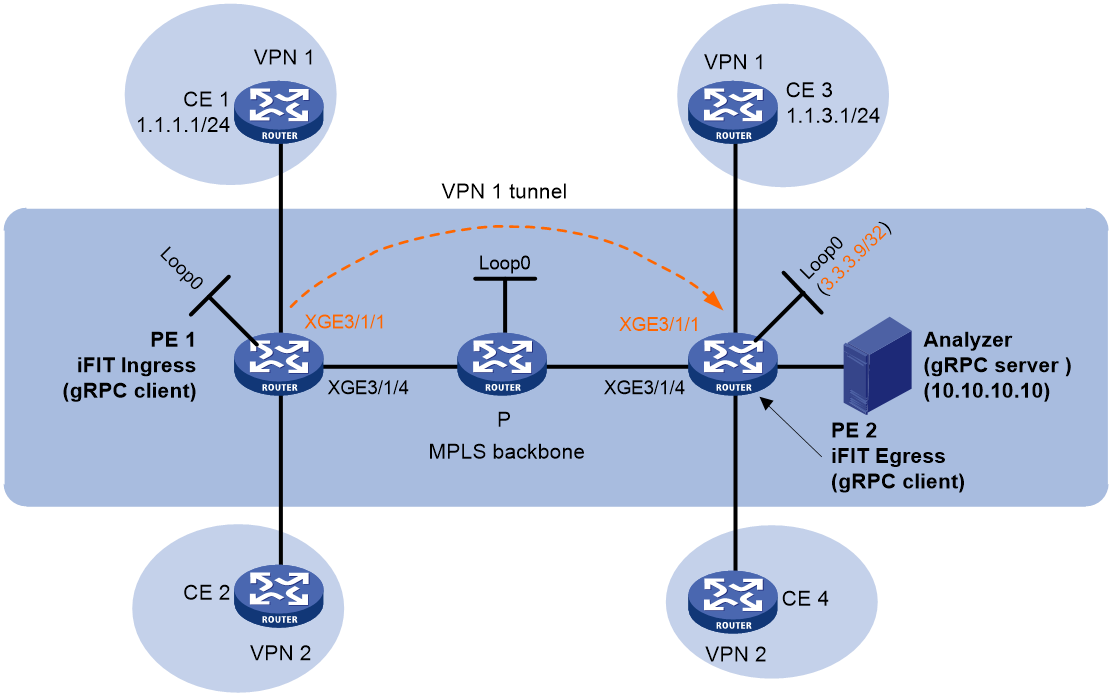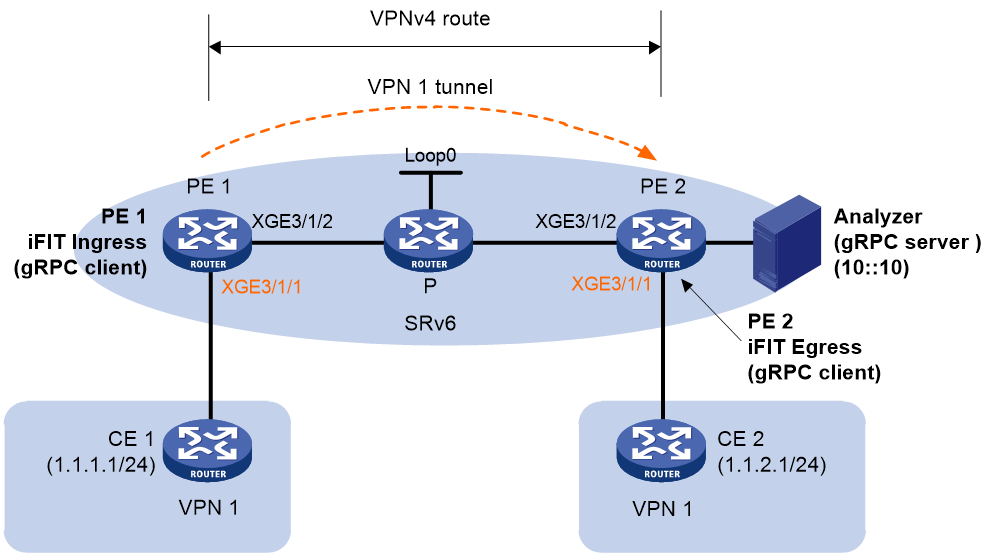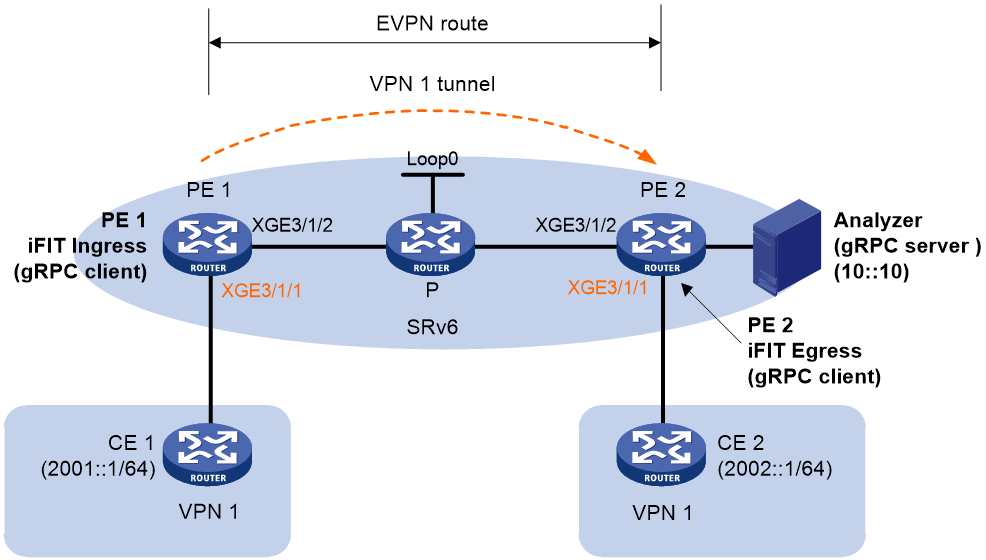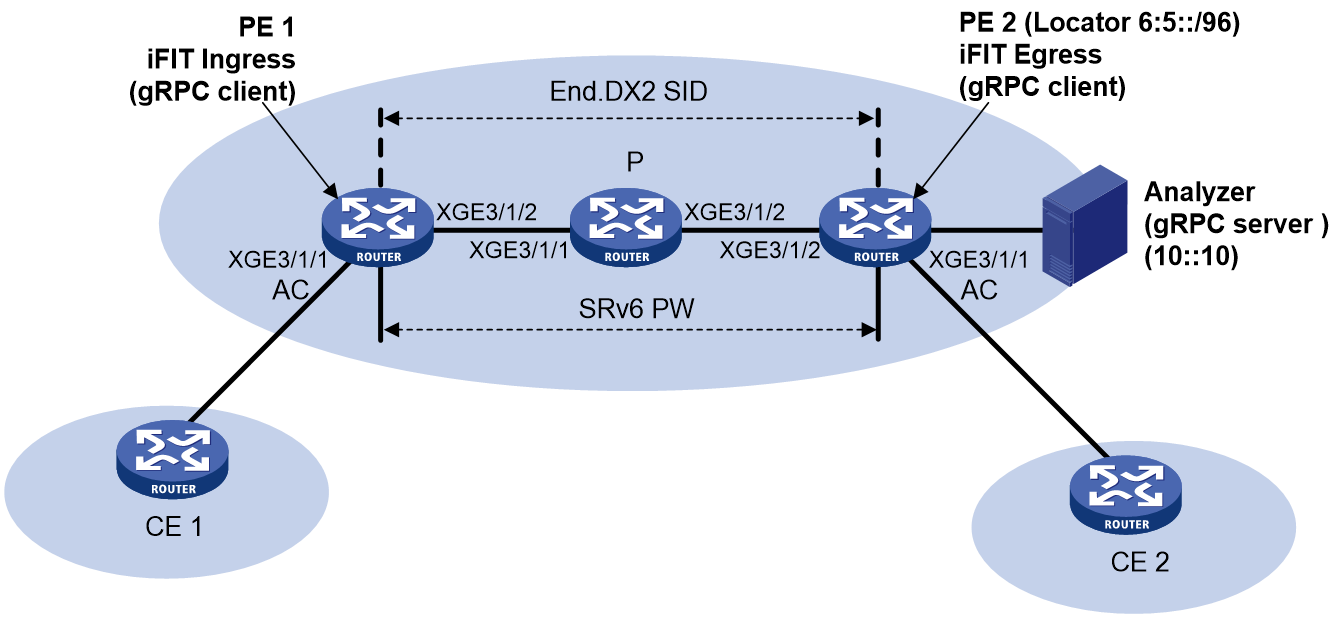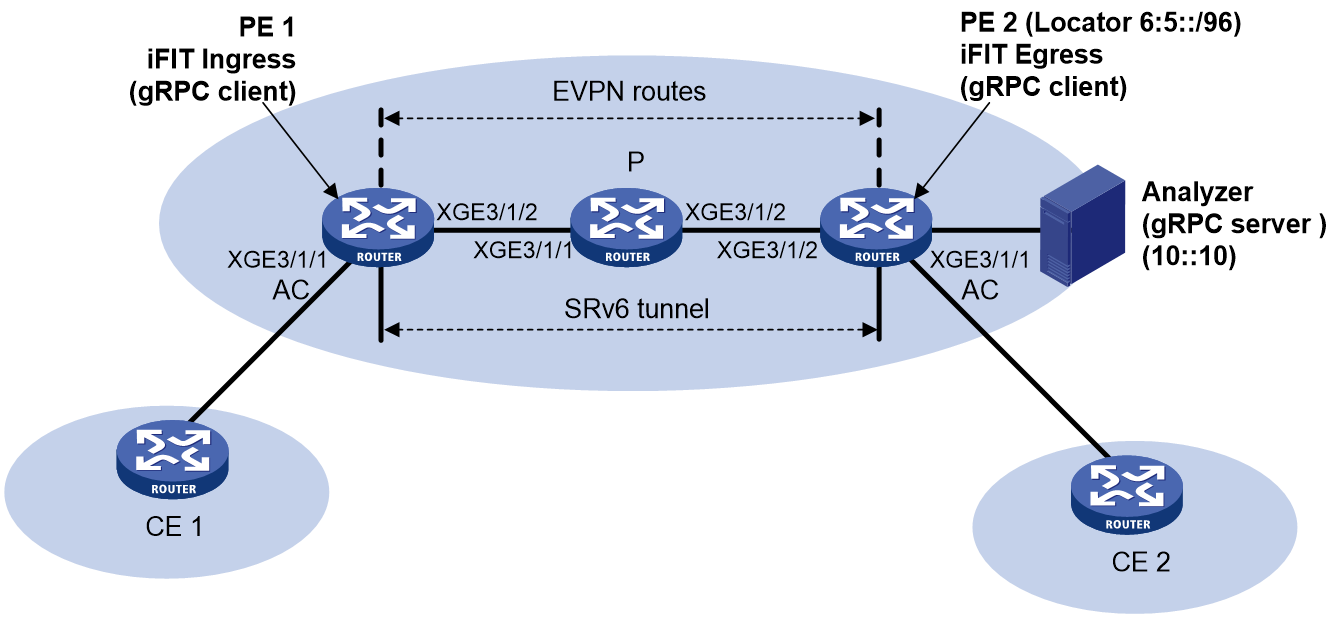- Table of Contents
-
- 15-Network Management and Monitoring Configuration Guide
- 00-Preface
- 01-System maintenance and debugging configuration
- 02-NQA configuration
- 03-iNQA configuration
- 04-iFIT configuration
- 05-SRPM configuration
- 06-NTP configuration
- 07-PTP configuration
- 08-Network synchronization configuration
- 09-SNMP configuration
- 10-RMON configuration
- 11-NETCONF configuration
- 12-CWMP configuration
- 13-EAA configuration
- 14-Process monitoring and maintenance configuration
- 15-Sampler configuration
- 16-Mirroring configuration
- 17-NetStream configuration
- 18-IPv6 NetStream configuration
- 19-TCP connection trace configuration
- 20-Performance management configuration
- 21-Fast log output configuration
- 22-Flow log configuration
- 23-Information center configuration
- 24-Packet capture configuration
- 25-Flow monitor configuration
- Related Documents
-
| Title | Size | Download |
|---|---|---|
| 04-iFIT configuration | 388.34 KB |
Configuring a measurement mode
Configuring a measurement period
Configuring a transmit point and the egress point
Display and maintenance commands for iFIT
Example: Configuring iFIT in an MPLS private network
Example: Configuring iFIT in an IPv4 L3VPN over SRv6 network
Example: Configuring iFIT in an IPv6 EVPN L3VPN over SRv6 network
Example: Configuring iFIT in an EVPN VPWS over SRv6 network
Example: Configuring iFIT in an EVPN VPLS over SRv6 network
Configuring iFIT
About iFIT
In-situ Flow Information Telemetry (iFIT) determines network performance by measuring the packet loss and packet delay of service packets transmitted on an MPLS, SR-MPLS, SRv6, G-SRv6, or G-BIER network. iFIT is easy to deploy and provides an accurate assessment of network performance.
Application scenarios
The iFIT header of an MPLS packet contains a field to specify the measurement mode, so both end-to-end measurement and hop-by-hop measurement are supported in an MPLS network. The iFIT header of an SR or SRv6 packet does not contain such field, so only hop-by-hop measurement is supported in the SR and SRV6 network even if end-to-end measurement is specified.
End-to-end measurement
To measure the packet loss and packet delay on the entire network, use end-to-end measurement. As shown in Figure 1, iFIT measures whether packet loss or packet delay occurs between the ingress point (where the target flow enters the IP network) and the egress point (where the flow leaves the network).
Figure 1 End-to-end measurement
Hop-by-hop measurement
To accurately locate the packet loss and packet delay of each network node, use hop-by-hop measurement. To locate the faulty node, you can divide an end-to-end network into smaller measurement spans. As shown in Figure 2, iFIT measures whether the packet loss and packet delay occurs between the ingress point and egress point, ingress point and transmit point, transmit point and egress point.
Figure 2 Hop-by-hop measurement
iFIT architecture
Figure 1 and Figure 2 show the important iFIT concepts including target flow, transit network, and measurement system.
Target flow
iFIT provides statistics on a per-flow basis. The target flows can be divided into the following types:
· Static flow—A static flow is a service flow that matches a set of criteria configured on the ingress point. The ingress point generates a static flow after you enable iFIT measurement and execute the flow command to configure the flow match criteria on the ingress point. The static flow is uniquely identified by a device ID and a flow ID. The device ID is configured by the device-id command and the flow ID is a number randomly generated on the ingress point in the range of 1 to 1048575. The device ID and flow ID are encapsulated in the iFIT header and passed to the transmit points and egress point.
To view the device ID and flow ID of a static flow on the ingress point, execute the display ifit flow static command.
An iFIT header contains fields to carry device ID, flow ID, measurement period, measurement mode, status of packet delay measurement, and status of packet loss measurement.
¡ A device ID uniquely identifies a device in an iFIT measurement network.
¡ A flow ID is automatically generated on the ingress point and passed to the transmit points and egress point. A flow ID and a device ID uniquely identify a flow together.
¡ Within a measurement period, the device starts iFIT measurement, collects and reports the measurement data.
¡ The available measurement mode includes end-to-end measurement and hop-by-hop measurement.
· Dynamic flow—A dynamic flow is a service flow dynamically learnt by the device. Dynamic flows are generated as follows:
¡ For the ingress point, if the device receives a packet that matches static flow settings, a dynamic flow with the same flow ID as the static flow is generated.
¡ For a transmit point and the egress point, they parse the received packets and generate dynamic flows by dynamically learning from the iFIT headers of the packets.
The device uses the device ID and flow ID in the iFIT header to identify the flow. If the device does not receive the packets using the same device ID and the same flow ID for a period of time, the device will delete the dynamic flow entry.
Detection point
A detection point is an interface where iFIT measurement is performed. You can specify detection points as required.
Transit network
The transit network only bears target flows. The target flows are not generated or terminated on the transit network. The transit network can only be a Layer 3 network. Each node on the transit network must be reachable.
Measurement system
The measurement system includes the following device role:
· The ingress point refers to the point that the flow enters the transit network. It filters the target flow, adds iFIT headers to the packets of the flow, collects packet statistics and reports packet statistics to the analyzer.
· A transmit point identifies the target flow by the iFIT header and reports the measurement statistics to the analyzer according to the measurement mode in the iFIT header.
· The egress point identifies the target flow by the iFIT header, reports the measurement statistics to the analyzer, and removes the iFIT header from the packet.
· The analyzer collects the statistics reported by the ingress point, transmit points, and egress point for data summarization and calculation.
Operating mechanism
Time synchronization mechanism
Before starting the iFIT measurement, make sure all devices are time synchronized. Therefore, all iFIT-enabled devices can use the same measurement period to report the packet statistics to the analyzer. As a best practice, the analyzer and all iFIT-enabled devices are time synchronized to facilitate management and maintenance.
You can use NTP and PTP to synchronize time between devices. Time synchronized through NTP is accurate to milliseconds and time synchronized through PTP is accurate to sub-microseconds. Select NTP or PTP as follows:
· For iFIT measurement on only packet loss, you can use NTP.
· For iFIT measurement on the delay, use PTP. This is because network delay is related to distance of physical links and network status, and the transmission delay on links might be less than one millisecond. In this case, using NTP affects the accuracy of iFIT measurement on the delay.
As a best practice, use PTP for time synchronization in an iFIT measurement network. For more information about NTP and PTP, see "Configuring NTP" and "Configuring PTP", respectively.
Packet loss measurement mechanism
The number of incoming packets and that of outgoing packets in a network should be equal within a measurement period. If they are not equal, packet loss occurs in the transit network.
Packet delay measurement mechanism
When a packet pass through multiple detection points, each point will record the timestamp when the packet passes through the point and report the recorded timestamp to the analyzer. Then the analyzer can use the timestamp values reported by different detection points to calculate the packet delay.
Measurement data reporting mechanism
iFIT-enabled devices push the measurement data to the analyzer by using the gRPC protocol.
Currently, only gRPC dial-out mode is supported. In this mode, iFIT-enabled devices act as gRPC clients and the analyzer acts as a gRPC server (also called a gRPC collector in the gRPC protocol).
An iFIT-enabled device can send the iFIT data to the analyzer at either of the following intervals:
· gRPC subscription interval—If you set a gRPC subscription interval when configuring gRPC subscription, the device sends the iFIT data to the analyzer at the gRPC subscription interval after establishing a gRPC connection to the analyzer, regardless of whether the sampling path is a periodic sampling path or an event-trigger sampling path.
· iFIT measurement interval—If you do not set a gRPC subscription interval when configuring gRPC subscription and the sampling path is a periodic sampling path, the device cannot send the iFIT data to the analyzer. If you do not set a gRPC subscription interval when configuring gRPC subscription and the sampling path is an event-trigger sampling path, the device sends the iFIT data to the analyzer at the iFIT measurement interval after establishing a gRPC connection to the analyzer.
|
|
NOTE: · The iFIT periodic sampling path is ifit/flowstatistics/flowstatistic. · The iFIT event-trigger sampling paths are insuitoam/measurereport (containing iFIT measurement result) and insuitoam/flowinfo (containing iFIT flow information). |
For more information about gRPC, see gRPC configuration in Telemetry Configuration Guide. For more information about iFIT sampling paths, see the NETCONF API documentation of iFIT.
Working mechanism
The following illustrates the working mechanism of hop-by-hop measurement. No transmit points exist in end-to-end measurement but end-to-end measurement works similarly as hop-by-hop measurement.
As shown in Figure 3, the flow passes through four devices. Three devices are enabled with iFIT. The iFIT measurement works as follows:
1. The analyzer synchronizes the time with all iFIT-enabled devices through the PTP protocol.
2. The iFIT-enabled devices takes the following actions:
a. The ingress point parses the packets to identify the target flow. It encapsulates iFIT headers to the packets, counts the number of packets, and reports the packet quantity and timestamp to the analyzer through gRPC periodically.
The ingress point is the interface bound to the target flow.
b. A transmit point counts the number of packets containing iFIT headers and reports the packet quantity and timestamp to the analyzer through gRPC periodically.
When the target flow passes through an iFIT-enabled device, the interfaces where the target flow enters the iFIT-enabled device and leaves the iFIT-enabled device are transmit points.
c. The egress point parses the packets to identify the target flow. It counts the number of packets containing iFIT headers, reports the packet quantity and timestamp to the analyzer through gRPC periodically, removes iFIT headers from the packets and forwards the packets.
When the target flow leaves the transit network, the interface where the target flow leaves the iFIT-enabled device is the egress point.
3. The analyzer calculate the packet delay for the target flow of the same period and same instance.
Restrictions and guidelines
In standard system operating mode, only the following cards support this feature:
CSPEX-1802X, CSPEX-1802XA, CSPEX-1812X-E, CSPEX-2304X-G, CEPC-CQ8L, CEPC-CQ8LA, CEPC-CQ16L1, CSPEX-1502XA, RX-SPE200-E
In SDN-WAN system operating mode, only the following cards support this feature:
CSPEX-1304X, CSPEX-1404X, CSPEX-1502X, CSPEX-1504X, CSPEX-1504XA, CSPEX-1602X, CSPEX-1602XA, CSPEX-1804X, CSPEX-1512X, CSPEX-1612X, CSPEX-1812X, RX-SPE200, CEPC-XP4LX, CEPC-XP24LX, CEPC-XP48RX, CEPC-CP4RX, CEPC-CP4RXA, CEPC-CP4RX-L, CSPEX-1802X, CSPEX-1802XA, CSPEX-1812X-E, CSPEX-2304X-G, CEPC-CQ8L, CEPC-CQ8LA, CEPC-CQ16L1, CSPEX-1502XA, RX-SPE200-E
For CSPEX-1304X, CSPEX-1404X, CSPEX-1502X, CSPEX-1504X, CSPEX-1504XA, CSPEX-1602X, CSPEX-1602XA, CSPEX-1804X, CSPEX-1512X, CSPEX-1612X, CSPEX-1812X, RX-SPE200, CEPC-XP4LX, CEPC-XP24LX, CEPC-XP48RX, CEPC-CP4RX, CEPC-CP4RXA, CEPC-CP4RX-L cards:
· In Layer 2 VPN scenarios, iFIT measurement is not supported.
· iFIT measurement based on the PeerLocator granularity is not supported.
An iFIT instance monitors only one flow. If you configure flows multiple times for an iFIT instance, the most recent configuration takes effect.
For the flows to be monitored by different instances, the flow attributes must not be identical and cannot conflict to avoid inaccurate measurement result.
As a best practice, configure iFIT first on the transmit points and the egress point and then the ingress point. Thus, the measurement results of the previous measurement periods will not affected if iFIT measurement starts on the ingress point but not on the transmit points and the egress point.
Modifying the iFIT instance or restarting the ingress point will cause flow ID change, which might cause inaccurate measurement data or no data in several measurement periods.
SRv6/G-SRv6 includes SRv6/G-SRv6 TE and SRv6/G-SRv6 BE networks. The iFIT configuration varies by network type as follows:
· In an SRv6/G-SRv6 TE network, configure iFIT on nodes in a SID list. If a transmit point is not in a SID list, iFIT measurement cannot be performed even after you configure iFIT on the transmit point.
· In an SRv6/G-SRv6 BE network, if you specify hop-by-hop measurement as the measurement mode, iFIT generates iFIT data only on the ingress and egress nodes during SRv6/G-SRv6 forwarding. The transmit nodes only forward IPv6 packets and do not participate in SRv6/G-SRv6 processing, so no iFIT data is generated on the transmit nodes.
Prerequisites
Before configuring iFIT, make sure the analyzer and iFIT-enabled devices are time synchronized through PTP. For more information about PTP, see "Configuring PTP."
To enable the iFIT-enabled devices to report the measurement results to the analyzer, configure gRPC on the analyzer and iFIT-enabled devices. For more information about gRPC, see gRPC configuration in Telemetry Configuration Guide.
Configuring the ingress point
Tasks at a glance
To configure the ingress point, perform the following tasks:
· Configuring a detection point
· Configuring a measurement mode
· Configuring a measurement period
Configuring iFIT
1. Enter system view.
system-view
2. Enable the iFIT functionality globally and enter its view, or enter the existing iFIT view.
ifit enable
By default, the iFIT functionality is disabled.
3. Specify a device ID.
device-id device-id
By default, no device ID is specified.
A device ID is required and uniquely identifies a device in an iFIT measurement network.
Creating an iFIT instance
1. Enter system view.
system-view
2. Enter iFIT view.
ifit enable
3. Create an iFIT instance and enter its view.
instance instance-name
Configuring a static flow
About this task
The target flows are key elements for iFIT measurement. Before starting an iFIT measurement, you must specify a static flow to be measured on the ingress point. You do not need to specify a static flow on the transmit points and egress point because the device can automatically learn the static flow through the iFIT header of the packets.
The device can perform iFIT measurement based on the following granularities in different scenarios:
· 5-tuple granularity—Used for measuring communication quality of service flows. You can use 5-tuple elements to match service flows. This granularity is available for all networks supported by iFIT.
· PeerLocator granularity—Used for measuring end-to-end communication quality on the entire network. In an IPv6 network, the peer-locator keyword can specify a tunnel. The device performs iFIT measurement on all service flows through the tunnel. This granularity is available only for SRv6 and G-SRv6 networks.
Procedure
1. Enter system view.
system-view
2. Enter iFIT view.
ifit enable
3. Specify a next hop for iFIT encapsulation.
encapsulation nexthop ip-address
By default, no next hop is specified for iFIT encapsulation.
In an MPLS or SR-MPLS network, you must execute this command to specify a peer PE for iFIT encapsulation. The device performs iFIT encapsulation only for service flows sent to the specified peer PE.
In an SRv6, G-SRv6, or G-BIER network, you do not need to execute this command. This command does not take effect on these networks.
4. Create an iFIT instance and enter its view.
instance instance-name
5. In an MPLS or SR-MPLS public network, specify a static flow to be monitored by the instance based on the 5-tuple granularity.
¡ IPv4 service flow:
flow unidirection source-ip src-ip-address [ src-mask-length ] destination-ip dest-ip-address [ dest-mask-length ] [ protocol { { sctp | tcp | udp } [ source-port src-port-number ] [ destination-port dest-port-number ] | protocol-number } ] [ dscp dscp-value ]
¡ IPv6 service flow:
IPv6 service flows are not supported in the current software version.
By default, no static flow is specified for an iFIT instance.
6. In an MPLS or SR-MPLS private network, specify a static flow to be monitored by the instance based on the 5-tuple granularity.
¡ IPv4 service flow:
flow unidirection source-ip src-ip-address [ src-mask-length ] destination-ip dest-ip-address [ dest-mask-length ] [ protocol { { sctp | tcp | udp } [ source-port src-port-number ] [ destination-port dest-port-number ] | protocol-number } ] [ dscp dscp-value ] vpn-instance vpn-instance-name
¡ IPv6 service flow:
flow unidirection source-ipv6 src-ipv6-address [ src-prefix-length ] destination-ipv6 dest-ipv6-address [ dest-prefix-length ] [ protocol { { sctp | tcp | udp } [ source-port src-port-number ] [ destination-port dest-port-number ] | protocol-number } ] [ dscp dscp-value ] vpn-instance vpn-instance-name
By default, no static flow is specified for an iFIT instance.
7. In an EVPN VPLS over MPLS/SR-MPLS network, specify a static flow to be monitored by the instance based on the 5-tuple granularity.
¡ IPv4 service flow:
flow unidirection source-ip src-ip-address [ src-mask-length ] destination-ip dest-ip-address [ dest-mask-length ] [ protocol { { sctp | tcp | udp } [ source-port src-port-number ] [ destination-port dest-port-number ] | protocol-number } ] [ dscp dscp-value ] vsi vsi-name
¡ IPv6 service flow:
flow unidirection source-ipv6 src-ipv6-address [ src-prefix-length ] destination-ipv6 dest-ipv6-address [ dest-prefix-length ] [ protocol { { sctp | tcp | udp } [ source-port src-port-number ] [ destination-port dest-port-number ] | protocol-number } ] [ dscp dscp-value ] vsi vsi-name
By default, no static flow is specified for an iFIT instance.
8. In an EVPN VPWS over MPLS/SR-MPLS network, specify a static flow to be monitored by the instance based on the 5-tuple granularity.
¡ IPv4 service flow:
flow unidirection source-ip src-ip-address [ src-mask-length ] destination-ip dest-ip-address [ dest-mask-length ] [ protocol { { sctp | tcp | udp } [ source-port src-port-number ] [ destination-port dest-port-number ] | protocol-number } ] [ dscp dscp-value ] xconnect-group group-name connection connection-name
¡ IPv6 service flow:
flow unidirection source-ipv6 src-ipv6-address [ src-prefix-length ] destination-ipv6 dest-ipv6-address [ dest-prefix-length ] [ protocol { { sctp | tcp | udp } [ source-port src-port-number ] [ destination-port dest-port-number ] | protocol-number } ] [ dscp dscp-value ] xconnect-group group-name connection connection-name
By default, no static flow is specified for an iFIT instance.
9. In a public network IPv4 over SRv6/G-SRv6 scenario, specify a static flow to be monitored by the instance.
¡ iFIT measurement based on the 5-tuple granularity:
- IPv4 service flow:
flow unidirection source-ip src-ip-address [ src-mask-length ] destination-ip dest-ip-address [ dest-mask-length ] [ protocol { { sctp | tcp | udp } [ source-port src-port-number ] [ destination-port dest-port-number ] | protocol-number } ] [ dscp dscp-value ]
- IPv6 service flow:
flow unidirection source-ipv6 src-ipv6-address [ src-prefix-length ] destination-ipv6 dest-ipv6-address [ dest-prefix-length ] [ protocol { { sctp | tcp | udp } [ source-port src-port-number ] [ destination-port dest-port-number ] | protocol-number } ] [ dscp dscp-value ]
¡ iFIT measurement based on the PeerLocator granularity:
- IPv4 service flow:
flow unidirection source-ip any destination-ip any peer-locator ipv6-address prefix-length
- IPv6 service flow:
flow unidirection source-ipv6 any destination-ipv6 any peer-locator ipv6-address prefix-length
By default, no static flow is specified for an iFIT instance.
10. In an L3VPN/EVPN L3VPN over SRv6/G-SRv6 network, specify a static flow to be monitored by the instance.
¡ iFIT measurement based on the 5-tuple granularity:
- IPv4 service flow:
flow unidirection source-ip src-ip-address [ src-mask-length ] destination-ip dest-ip-address [ dest-mask-length ] [ protocol { { sctp | tcp | udp } [ source-port src-port-number ] [ destination-port dest-port-number ] | protocol-number } ] [ dscp dscp-value ] vpn-instance vpn-instance-name
- IPv6 service flow:
flow unidirection source-ipv6 src-ipv6-address [ src-prefix-length ] destination-ipv6 dest-ipv6-address [ dest-prefix-length ] [ protocol { { sctp | tcp | udp } [ source-port src-port-number ] [ destination-port dest-port-number ] | protocol-number } ] [ dscp dscp-value ] vpn-instance vpn-instance-name
¡ iFIT measurement based on the PeerLocator granularity:
- IPv4 service flow:
flow unidirection source-ip any destination-ip any [ vpn-instance vpn-instance-name ] peer-locator ipv6-address prefix-length
- IPv6 service flow:
flow unidirection source-ipv6 any destination-ipv6 any [ vpn-instance vpn-instance-name ] peer-locator ipv6-address prefix-length
By default, no static flow is specified for an iFIT instance.
11. In an EVPN VPLS over SRv6/G-SRv6 network, specify a static flow to be monitored by the instance.
¡ iFIT measurement based on the 5-tuple granularity:
- IPv4 service flow:
flow unidirection source-ip src-ip-address [ src-mask-length ] destination-ip dest-ip-address [ dest-mask-length ] [ protocol { { sctp | tcp | udp } [ source-port src-port-number ] [ destination-port dest-port-number ] | protocol-number } ] [ dscp dscp-value ] vsi vsi-name
- IPv6 service flow:
flow unidirection source-ipv6 src-ipv6-address [ src-prefix-length ] destination-ipv6 dest-ipv6-address [ dest-prefix-length ] [ protocol { { sctp | tcp | udp } [ source-port src-port-number ] [ destination-port dest-port-number ] | protocol-number } ] [ dscp dscp-value ] vsi vsi-name
¡ iFIT measurement based on the PeerLocator granularity:
flow unidirection vsi vsi-name peer-locator ipv6-address prefix-length
By default, no static flow is specified for an iFIT instance.
12. In an EVPN VPWS over SRv6/G-SRv6 network, specify a static flow to be monitored by the instance.
¡ iFIT measurement based on the 5-tuple granularity:
- IPv4 service flow:
flow unidirection source-ip src-ip-address [ src-mask-length ] destination-ip dest-ip-address [ dest-mask-length ] [ protocol { { sctp | tcp | udp } [ source-port src-port-number ] [ destination-port dest-port-number ] | protocol-number } ] [ dscp dscp-value ] xconnect-group group-name connection connection-name
- IPv6 service flow:
flow unidirection source-ipv6 src-ipv6-address [ src-prefix-length ] destination-ipv6 dest-ipv6-address [ dest-prefix-length ] [ protocol { { sctp | tcp | udp } [ source-port src-port-number ] [ destination-port dest-port-number ] | protocol-number } ] [ dscp dscp-value ] xconnect-group group-name connection connection-name
¡ iFIT measurement based on the PeerLocator granularity:
flow unidirection xconnect-group group-name connection connection-name peer-locator ipv6-address prefix-length
By default, no static flow is specified for an iFIT instance.
13. In a G-BIER network, specify a static flow to be monitored by the instance.
flow unidirection source-ipv6 src-ipv6-address [ src-prefix-length ] destination-ipv6 dest-ipv6-address [ dest-prefix-length ] [ protocol { { sctp | tcp | udp } [ source-port src-port-number ] [ destination-port dest-port-number ] | protocol-number } ] [ dscp dscp-value ] [ vpn-instance vpn-instance-name ]
By default, no static flow is specified for an iFIT instance.
Configuring a detection point
About this task
Before enabling iFIT measurement on the ingress point of an instance, you must bind an interface to the instance. After you bind an interface to an instance, iFIT parses the packets passing through the interface to identify the target packets and add an iFIT header to each target packets. Meanwhile, iFIT will count the number of target packets, and send the packet count and timestamp to the analyzer at intervals through gRPC.
You can configure only one set of flow match criteria for an instance. An instance can be bound to multiple interfaces. Each bound interface matches target flows based on the same set of criteria and assigns different flow IDs to target flows. iFIT measures the delay and packet loss of target flows on a per-interface basis.
Procedure
1. Enter system view.
system-view
2. Enter iFIT view.
ifit enable
3. Create an iFIT instance and enter its view.
instance instance-name
4. Bind an interface to the instance.
bind interface interface-type interface-number
By default, an instance is not bound to any interfaces.
Configuring a measurement mode
1. Enter system view.
system-view
2. Enter iFIT view.
ifit enable
3. Create an iFIT instance and enter its view.
instance instance-name
4. Specify an iFIT measurement mode.
measure mode { e2e | trace }
By default, end-to-end measurement is used.
Configuring a measurement period
About this task
iFIT collects performance statistics based on the measurement period.
· The sender records the sending time of the first iFIT packet in each sending interval, and counts the number of the iFIT packets sent from an interface in each sending interval. Sending interval = iFIT measurement period.
· The receiver records the receiving time of the first iFIT packet in each receiving interval, and counts the number of the iFIT packets received by an interface in each receiving interval. To reduce the impact of network delay and disorder on statistics, the receiving interval equals to (1+1/3) measurement period.
If network delay between the ingress and egress points is greater than 1/3 measurement period, the accuracy of iFIT packet loss statistics might be affected. This is because iFIT considers packets received beyond the receiving interval as packet loss. For example, the measurement period is 1 second and the network delay is greater than 1/3 seconds (333 milliseconds). In this case, set the measurement period to a greater value.
Prcedure
1. Enter system view.
system-view
2. Enter iFIT view.
ifit enable
3. Create an iFIT instance and enter its view.
instance instance-name
4. Specify the measurement period for the iFIT instance.
period period
By default, the measurement period for an iFIT instance is 30 seconds.
Enabling iFIT measurement
About this task
You can configure packet loss measurement and packet delay measurement as required. Both packet loss measurement and packet delay measurement are enabled by default. You cannot disable packet loss measurement from the CLI, but can disable packet delay measurement from the CLI.
Procedure
1. Enter system view.
system-view
2. Enter iFIT view.
ifit enable
3. Create an iFIT instance and enter its view.
instance instance-name
4. (Optional.) Disable packet delay measurement.
delay-measure disable
By default, packet delay measurement is enabled.
5. Enable iFIT measurement for the iFIT instance.
measure enable
By default, iFIT measurement for an iFIT instance is disabled.
Configuring a transmit point and the egress point
Tasks at a glance
Transmit points are required only for hop-by-hop measurement. For end-to-end measurement, do not configure transmit points.
To configure a transmit point or the ingress point, perform the following tasks:
· (Optional.) Managing a dynamic flow
Configuring iFIT
1. Enter system view.
system-view
2. Enable the iFIT functionality globally and enter its view.
ifit enable
By default, the iFIT functionality is disabled.
Managing a dynamic flow
1. Enter system view.
system-view
2. Enable the iFIT functionality globally and enter its view.
ifit enable
3. Specify the aging parameters for dynamic flows.
dynamic-flow aging-time multi-value [ threshold-percent threshold-percent ]
By default, the aging time for dynamic flows is 10 times the measurement period and it cannot be less than 5 minutes.
4. Delete iFIT dynamic flows.
delete dynamic-flow { device-id device-id flow-id flow-id | all }
Display and maintenance commands for iFIT
Execute display commands in any view.
|
Task |
Command |
|
Display dynamic flow information. |
display ifit flow dynamic [ device-id device-id flow-id flow-id ] |
|
Display static flow information. |
display ifit flow static [ flow-id flow-id ] |
|
Display global information about iFIT target flows. |
display ifit global-information |
|
Display iFIT instance information. |
display ifit instance [ instance-name ] |
|
Display statistics about an iFIT dynamic flow for the most recent 10 measurement periods. |
display ifit statistic device-id device-id flow-id flow-id [ verbose ] |
|
Clear iFIT statistics of dynamic flows for the most recent 10 measurement periods. |
reset ifit statistic [ device-id device-id flow-id flow-id | instance instance-name] |
iFIT configuration examples
Example: Configuring iFIT in an MPLS private network
As shown in Figure 4:
· Configure IPv4 EVPN L3VPN for different sites of a VPN instance to communicate with each other.
· Configure the CE and the PE of each site to use EBGP to exchange VPN routes.
· Configure the PEs to communicate through OSPF and to exchange BGP EVPN routes through MP-IBGP.
· Configure iFIT to monitor the occurrence of packet loss and packet delay value when the flow passes through the VPN 1 tunnel.
Prerequisites
1. Configure EVPN L3VPN. (Details not shown.)
For information about configuring EVPN L3VPN, see EVPN L3VPN configuration in EVPN Configuration Guide.
2. Configure PTP on PE 1 and PE 2 for clock synchronization. (Details not shown.)
For information about configuring PTP, see "Configuring PTP."
Procedure
1. Configure PE 1:
a. Configure gRPC:
# Enable the gRPC service.
<PE1> system-view
[PE1] grpc enable
# Create a sensor group named test, and add sensor path ifit/flowstatistics/flowstatistic.
[PE1] telemetry
[PE1-telemetry] sensor-group test
[PE1-telemetry-sensor-group-test] sensor path ifit/flowstatistics/flowstatistic depth 2
[PE1-telemetry-sensor-group-test] quit
# Create a destination group named collector1. Specify a collector that uses IPv4 address 10.10.10.10 and port number 50050.
[PE1-telemetry] destination-group collector1
[PE1-telemetry-destination-group-collector1] ipv4-address 10.10.10.10 port 50050
[PE1-telemetry-destination-group-collector1] quit
# Configure a subscription named A to bind sensor group test with destination group collector1. Set the sampling interval to 5 seconds.
[PE1-telemetry] subscription A
[PE1-telemetry-subscription-A] sensor-group test sample-interval 5
[PE1-telemetry-subscription-A] destination-group collector1
[PE1-telemetry-subscription-A] quit
[PE1-telemetry] quit
b. Configure iFIT:
# Enable the iFIT functionality.
[PE1] ifit enable
[PE1-ifit] device-id 1
# Configure instance a to monitor the unidirectional flow from source IP 1.1.1.1/24 to destination IP 1.1.3.1/24 with the PE at 3.3.3.9 as the next hop in VPN instance vpn1.
[PE1-ifit] encapsulation nexthop 3.3.3.9
[PE1-ifit] instance a
[PE1-ifit-instance-a] flow unidirection source-ip 1.1.1.1 24 destination-ip 1.1.3.1 24 vpn-instance vpn1
# Bind interface Ten-GigabitEthernet 3/1/1 to instance a.
[PE1-ifit-instance-a] bind interface ten-gigabitethernet 3/1/1
# Specify 10 seconds as the measurement period.
[PE1-ifit-instance-a] period 10
# Specify end-to-end measurement as the measurement mode.
[PE1-ifit-instance-a] measure mode e2e
# Enable iFIT measurement.
[PE1-ifit-instance-a] measure enable
[PE1-ifit-instance-a] quit
[PE1-ifit] quit
2. Configure PE 2:
a. Configure gRPC.
Use the same procedure to configure gRPC on PE 2 as you configure gRPC on PE 1.
b. Enable the iFIT functionality.
<PE2> system-view
[PE2] ifit enable
Verifying the configuration
1. View iFIT statistics on PE 1.
[PE1] display ifit statistic device-id 1 flow-id 3
Period ID Direction Interface PktCount Timestamp(sec, nsec)
163059918 Ingress XGE3/1/1 4124 1630599180, 1889782
163059919 Ingress XGE3/1/1 4124 1630599190, 1901494
163059920 Ingress XGE3/1/1 4124 1630599200, 1912118
2. View iFIT statistics on PE 2.
[PE2] display ifit statistic device-id 1 flow-id 3
Period ID Direction Interface PktCount Timestamp(sec, nsec)
163059918 Egress XGE3/1/1 4124 1630599180, 1948185
163059919 Egress XGE3/1/1 4124 1630599190, 1959405
163059920 Egress XGE3/1/1 4120 1630599200, 1968503
3. Packet loss occurs in period 163059920 by viewing iFIT statistics on the analyzer.
Example: Configuring iFIT in an IPv4 L3VPN over SRv6 network
Network configuration
As shown in Figure 5, the backbone network is an IPv6 network, and VPN 1 is an IPv4 network. Deploy MPLS L3VPN over SRv6 between PE 1 and PE 2 and use an SRv6 tunnel to transmit VPNv4 traffic between the PEs.
· Configure EBGP to exchange VPN routing information between the CEs and PEs.
· Configure IPv6 IS-IS on the PEs in the same AS to realize IPv6 network connectivity.
· Configure MP-IBGP to exchange VPNv4 routing information between the PEs.
· Configure iFIT to monitor the occurrence of packet loss and packet delay value when the flow passes through the VPN 1 tunnel.
Prerequisites
1. Configure IPv4 L3VPN over SRv6. (Details not shown.)
For information about configuring MPLS L3VPN over SRv6, see IP L3VPN over SRv6 configuration in Segment Routing Configuration Guide.
2. Configure PTP on PE 1 and PE 2 for clock synchronization. (Details not shown.)
For information about configuring PTP, see "Configuring PTP."
Procedure
1. Configure PE 1:
a. Configure gRPC:
# Enable the gRPC service.
<PE1> system-view
[PE1] grpc enable
# Create a sensor group named test, and add sensor path ifit/flowstatistics/flowstatistic.
[PE1] telemetry
[PE1-telemetry] sensor-group test
[PE1-telemetry-sensor-group-test] sensor path ifit/flowstatistics/flowstatistic depth 2
[PE1-telemetry-sensor-group-test] quit
# Create a destination group named collector1. Specify a collector that uses IPv6 address 10::10 and port number 50050.
[PE1-telemetry] destination-group collector1
[PE1-telemetry-destination-group-collector1] ipv6-address 10::10 port 50050
[PE1-telemetry-destination-group-collector1] quit
# Configure a subscription named A to bind sensor group test with destination group collector1. Set the sampling interval to 5 seconds.
[PE1-telemetry] subscription A
[PE1-telemetry-subscription-A] sensor-group test sample-interval 5
[PE1-telemetry-subscription-A] destination-group collector1
[PE1-telemetry-subscription-A] quit
[PE1-telemetry] quit
b. Configure iFIT:
# Enable the iFIT functionality.
[PE1] ifit enable
[PE1-ifit] device-id 1
# Configure instance a to monitor the unidirectional flow from source IP 1.1.1.1/24 to destination IP 1.1.2.1/24 with VPN instance vpn1.
[PE1-ifit] instance a
[PE1-ifit-instance-a] flow unidirection source-ip 1.1.1.1 24 destination-ip 1.1.2.1 24 vpn-instance vpn1
# Bind interface Ten-GigabitEthernet 3/1/1 to instance a.
[PE1-ifit-instance-a] bind interface ten-gigabitethernet 3/1/1
# Specify 10 seconds as the measurement period.
[PE1-ifit-instance-a] period 10
# Enable iFIT measurement.
[PE1-ifit-instance-a] measure enable
[PE1-ifit-instance-a] quit
[PE1-ifit] quit
2. Configure PE 2:
a. Configure gRPC.
Use the same procedure to configure gRPC on PE 2 as you configure gRPC on PE 1.
b. Enable the iFIT functionality.
<PE2> system-view
[PE2] ifit enable
Verifying the configuration
1. View iFIT statistics on PE 1.
[PE1-ifit-instance-a] display ifit statistic device-id 1 flow-id 2
Period ID Direction Interface PktCount Timestamp(sec, nsec)
163059918 Ingress XGE3/1/1 4124 1630599180, 1889782
163059919 Ingress XGE3/1/1 4124 1630599190, 1901494
163059920 Ingress XGE3/1/1 4124 1630599200, 1912118
2. View iFIT statistics on PE 2.
[PE2] display ifit statistic device-id 1 flow-id 2
Period ID Direction Interface PktCount Timestamp(sec, nsec)
163059918 Egress XGE3/1/1 4124 1630599180, 1948185
163059919 Egress XGE3/1/1 4124 1630599190, 1959405
163059920 Egress XGE3/1/1 4120 1630599200, 1968503
3. Packet loss occurs in period 163059920 by viewing iFIT statistics on the analyzer.
Example: Configuring iFIT in an IPv6 EVPN L3VPN over SRv6 network
Network configuration
As shown in Figure 6, the backbone network is an IPv6 network. Deploy EVPN L3VPN over SRv6 in SRv6-BE mode between PE 1 and PE 2 and use an SRv6 tunnel to transmit EVPN traffic between the PEs.
· Configure EBGP to exchange VPN routing information between the CEs and PEs.
· Configure IPv6 IS-IS on the PEs in the same AS to realize IPv6 network connectivity.
· Configure MP-IBGP to exchange EVPN routing information between the PEs.
· Configure iFIT to monitor the occurrence of packet loss and packet delay value when the flow passes through the VPN 1 tunnel.
Prerequisites
1. Configure IPv6 EVPN L3VPN over SRv6. (Details not shown.)
For information about configuring IPv6 EVPN L3VPN over SRv6, see EVPN L3VPN over SRv6 configuration in Segment Routing Configuration Guide.
2. Configure PTP on PE 1 and PE 2 for clock synchronization. (Details not shown.)
For information about configuring PTP, see "Configuring PTP."
Procedure
1. Configure PE 1:
a. Configure gRPC:
# Enable the gRPC service.
<PE1> system-view
[PE1] grpc enable
# Create a sensor group named test, and add sensor path ifit/flowstatistics/flowstatistic.
[PE1] telemetry
[PE1-telemetry] sensor-group test
[PE1-telemetry-sensor-group-test] sensor path ifit/flowstatistics/flowstatistic depth 2
[PE1-telemetry-sensor-group-test] quit
# Create a destination group named collector1. Specify a collector that uses IPv6 address 10::10 and port number 50050.
[PE1-telemetry] destination-group collector1
[PE1-telemetry-destination-group-collector1] ipv6-address 10::10 port 50050
[PE1-telemetry-destination-group-collector1] quit
# Configure a subscription named A to bind sensor group test with destination group collector1. Set the sampling interval to 5 seconds.
[PE1-telemetry] subscription A
[PE1-telemetry-subscription-A] sensor-group test sample-interval 5
[PE1-telemetry-subscription-A] destination-group collector1
[PE1-telemetry-subscription-A] quit
[PE1-telemetry] quit
b. Configure iFIT:
# Enable the iFIT functionality.
[PE1] ifit enable
[PE1-ifit] device-id 1
# Configure instance a to monitor the unidirectional flow from source IP 2001::1 to destination IP 2002::1 with VPN instance vpn1.
[PE1-ifit] instance a
[PE1-ifit-instance-a] flow unidirection source-ipv6 2001::1 destination-ipv6 2002::1 vpn-instance vpn1
# Bind interface Ten-GigabitEthernet 3/1/1 to instance a.
[PE1-ifit-instance-a] bind interface ten-gigabitethernet 3/1/1
# Specify 10 seconds as the measurement period.
[PE1-ifit-instance-a] period 10
# Enable iFIT measurement.
[PE1-ifit-instance-a] measure enable
[PE1-ifit-instance-a] quit
[PE1-ifit] quit
2. Configure PE 2:
a. Configure gRPC.
Use the same procedure to configure gRPC on PE 2 as you configure gRPC on PE 1.
b. Enable the iFIT functionality.
<PE2> system-view
[PE2] ifit enable
Verifying the configuration
1. View iFIT statistics on PE 1.
[PE1-ifit-instance-a] display ifit statistic device-id 1 flow-id 2
Period ID Direction Interface PktCount Timestamp(sec, nsec)
163059918 Ingress XGE3/1/1 4124 1630599180, 1889782
163059919 Ingress XGE3/1/1 4124 1630599190, 1901494
163059920 Ingress XGE3/1/1 4124 1630599200, 1912118
2. View iFIT statistics on PE 2.
[PE2] display ifit statistic device-id 1 flow-id 2
Period ID Direction Interface PktCount Timestamp(sec, nsec)
163059918 Egress XGE3/1/1 4124 1630599180, 1948185
163059919 Egress XGE3/1/1 4124 1630599190, 1959405
163059920 Egress XGE3/1/1 4120 1630599200, 1968503
3. Packet loss occurs in period 163059920 by viewing iFIT statistics on the analyzer.
Example: Configuring iFIT in an EVPN VPWS over SRv6 network
Network configuration
As shown in Figure 7, user sites CE 1 and CE 2 connect to PE1 and PE 2, respectively through Ethernet interfaces. Configure CE 1 and CE 2 to communicate through an SRv6 tunnel over the IPv6 backbone network.
The two PEs set up an SRv6 tunnel after assigning End.DX2 SIDs to the cross-connect. On a PE, this SRv6 tunnel is used as an SRv6 PW to encapsulate and forward Layer 2 data packets received from the local site and destined for a remote site.
Configure iFIT to monitor the occurrence of packet loss and packet delay value when the flow passes through the SRv6 tunnel.
Prerequisites
1. Configure EVPN VPWS over SRv6. (Details not shown.)
For information about configuring EVPN VPWS over SRv6, see EVPN VPWS over SRv6 configuration in Segment Routing Configuration Guide.
2. Configure PTP on PE 1 and PE 2 for clock synchronization. (Details not shown.)
For information about configuring PTP, see "Configuring PTP."
Procedure
1. Configure PE 1:
a. Configure gRPC:
# Enable the gRPC service.
<PE1> system-view
[PE1] grpc enable
# Create a sensor group named test, and add sensor path ifit/flowstatistics/flowstatis.
[PE1] telemetry
[PE1-telemetry] sensor-group test
[PE1-telemetry-sensor-group-test] sensor path ifit/flowstatistics/flowstatistic depth 2
[PE1-telemetry-sensor-group-test] quit
# Create a destination group named collector1. Specify a collector that uses IPv6 address 10::10 and port number 50050.
[PE1-telemetry] destination-group collector1
[PE1-telemetry-destination-group-collector1] ipv6-address 10::10 port 50050
[PE1-telemetry-destination-group-collector1] quit
# Configure a subscription named A to bind sensor group test with destination group collector1. Set the sampling interval to 5 seconds.
[PE1-telemetry] subscription A
[PE1-telemetry-subscription-A] sensor-group test sample-interval 5
[PE1-telemetry-subscription-A] destination-group collector1
[PE1-telemetry-subscription-A] quit
[PE1-telemetry] quit
b. Configure iFIT:
# Enable the iFIT functionality.
[PE1] ifit enable
[PE1-ifit] device-id 1
# Configure instance a to monitor the service flow with cross-connect con1 of cross-connect group xca. The PeerlLocator for the service flow is 6:5::.
[PE1-ifit] instance a
[PE1-ifit-instance-a] flow unidirection xconnect-group xca connection con1 peer-locator 6:5:: 96
# Bind interface Ten-GigabitEthernet 3/1/1 to instance a.
[PE1-ifit-instance-a] bind interface ten-gigabitethernet 3/1/1
# Specify 10 seconds as the measurement period.
[PE1-ifit-instance-a] period 10
# Enable the iFIT functionality.
[PE1-ifit-instance-a] measure enable
[PE1-ifit-instance-a] quit
[PE1-ifit] quit
2. Configure PE 2:
a. Configure gRPC.
Use the same procedure to configure gRPC on PE 2 as you configure gRPC on PE 1.
b. Enable the iFIT functionality.
<PE2> system-view
[PE2] ifit enable
Verifying the configuration
1. View iFIT statistics on PE 1.
[PE1] display ifit statistic device-id 1 flow-id 2
Period ID Direction Interface PktCount Timestamp(sec, nsec)
163059918 Ingress XGE3/1/1 4124 1630599180, 1889782
163059919 Ingress XGE3/1/1 4124 1630599190, 1901494
163059920 Ingress XGE3/1/1 4124 1630599200, 1912118
2. View iFIT statistics on PE 2.
[PE2] display ifit statistic device-id 1 flow-id 2
Period ID Direction Interface PktCount Timestamp(sec, nsec)
163059918 Egress XGE3/1/1 4124 1630599180, 1948185
163059919 Egress XGE3/1/1 4124 1630599190, 1959405
163059920 Egress XGE3/1/1 4120 1630599200, 1968503
3. Packet loss occurs in period 163059920 by viewing iFIT statistics on the analyzer.
Example: Configuring iFIT in an EVPN VPLS over SRv6 network
Network configuration
As shown in Figure 8, user sites CE 1 and CE 2 connect to PE1 and PE 2, respectively through Ethernet interfaces. Configure CE 1 and CE 2 to achieve communicate through EVPN VPLS over SRv6 over the IPv6 backbone network.
PEs set up an SRv6 tunnel by advertising End.DT2M SIDs, End.DT2U SIDs, and End.DX2 SIDs to each other through BGP EVPN routes. On a PE, this SRv6 tunnel is used as a PW to encapsulate and forward Layer 2 data packets received from the local site and destined for a remote site.
Configure iFIT to monitor the occurrence of packet loss and packet delay value when the flow passes through the SRv6 tunnel.
Prerequisites
1. Configure EVPN VPLS over SRv6. (Details not shown.)
For information about configuring EVPN VPLS over SRv6, see EVPN VPLS over SRv6 configuration in EVPN Configuration Guide.
2. Configure PTP on PE 1 and PE 2 for clock synchronization. (Details not shown.)
For information about configuring PTP, see "Configuring PTP."
Procedure
1. Configure PE 1:
a. Configure gRPC:
# Enable the gRPC service.
<PE1> system-view
[PE1] grpc enable
# Create a sensor group named test, and add sensor path ifit/flowstatistics/flowstatis.
[PE1] telemetry
[PE1-telemetry] sensor-group test
[PE1-telemetry-sensor-group-test] sensor path ifit/flowstatistics/flowstatistic depth 2
[PE1-telemetry-sensor-group-test] quit
# Create a destination group named collector1. Specify a collector that uses IPv6 address 10::10 and port number 50050.
[PE1-telemetry] destination-group collector1
[PE1-telemetry-destination-group-collector1] ipv6-address 10::10 port 50050
[PE1-telemetry-destination-group-collector1] quit
# Configure a subscription named A to bind sensor group test with destination group collector1. Set the sampling interval to 5 seconds.
[PE1-telemetry] subscription A
[PE1-telemetry-subscription-A] sensor-group test sample-interval 5
[PE1-telemetry-subscription-A] destination-group collector1
[PE1-telemetry-subscription-A] quit
[PE1-telemetry] quit
b. Configure iFIT:
# Enable the iFIT functionality.
[PE1] ifit enable
[PE1-ifit] device-id 1
# Configure instance a to monitor the service flow with VSI vsi and PeerLocator 6:5::.
[PE1-ifit] instance a
[PE1-ifit-instance-a] flow unidirection vsi vsi1 peer-locator 6:5:: 96
# Bind interface Ten-GigabitEthernet 3/1/1 to instance a.
[PE1-ifit-instance-a] bind interface ten-gigabitethernet 3/1/1
# Specify 10 seconds as the measurement period.
[PE1-ifit-instance-a] period 10
# Enable the iFIT functionality.
[PE1-ifit-instance-a] measure enable
[PE1-ifit-instance-a] quit
[PE1-ifit] quit
2. Configure PE 2:
a. Configure gRPC:
Use the same procedure to configure gRPC on PE 2 as you configure gRPC on PE 1.
b. Enable the iFIT functionality.
<PE2> system-view
[PE2] ifit enable
Verifying the configuration
1. View iFIT statistics on PE 1.
[PE1] display ifit statistic device-id 1 flow-id 2
Period ID Direction Interface PktCount Timestamp(sec, nsec)
163059918 Ingress XGE3/1/1 4124 1630599180, 1889782
163059919 Ingress XGE3/1/1 4124 1630599190, 1901494
163059920 Ingress XGE3/1/1 4124 1630599200, 1912118
2. View iFIT statistics on PE 2.
[PE2] display ifit statistic device-id 1 flow-id 2
Period ID Direction Interface PktCount Timestamp(sec, nsec)
163059918 Egress XGE3/1/1 4124 1630599180, 1948185
163059919 Egress XGE3/1/1 4124 1630599190, 1959405
163059920 Egress XGE3/1/1 4120 1630599200, 1968503
3. Packet loss occurs in period 163059920 by viewing iFIT statistics on the analyzer.

